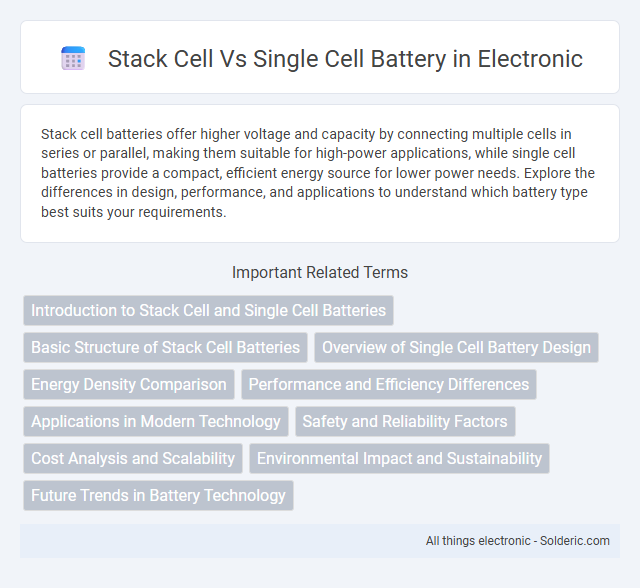Stack cell batteries offer higher voltage and capacity by connecting multiple cells in series or parallel, making them suitable for high-power applications, while single cell batteries provide a compact, efficient energy source for lower power needs. Explore the differences in design, performance, and applications to understand which battery type best suits your requirements.
Comparison Table
| Feature | Stack Cell Battery | Single Cell Battery |
|---|---|---|
| Definition | Multiple cells stacked to increase voltage or capacity. | Individual electrochemical cell producing a single voltage. |
| Voltage | Higher voltage output by connecting cells in series. | Standard voltage per cell (e.g., 1.2V, 3.7V). |
| Capacity | Increased capacity by parallel stacking. | Limited to the capacity of a single cell. |
| Size | Larger size due to multiple stacked cells. | Smaller, compact size. |
| Complexity | More complex design and assembly. | Simple design and manufacturing. |
| Applications | Used in electric vehicles, large battery packs, energy storage. | Used in small electronics, portable devices. |
| Cost | Higher cost due to multiple cells and assembly. | Lower cost per cell. |
Introduction to Stack Cell and Single Cell Batteries
Stack cells consist of multiple individual electrochemical cells connected in series or parallel to increase voltage or capacity, commonly used in applications requiring higher power output. Single cell batteries are individual units that provide a fixed voltage and capacity, suitable for low-power devices or as building blocks for larger battery assemblies. Your choice between stack cells and single cells depends on the required energy, space constraints, and device specifications.
Basic Structure of Stack Cell Batteries
Stack cell batteries consist of multiple single cells connected in series or parallel to increase voltage or capacity, encapsulated within a unified casing. Each single cell within the stack contains its own anode, cathode, and electrolyte, but the overall design enhances energy output and reliability. Your choice between stack cell and single cell batteries affects performance in applications requiring higher power density and scalability.
Overview of Single Cell Battery Design
Single cell battery design features a singular electrochemical cell that converts chemical energy into electrical energy, typically composed of an anode, cathode, separator, and electrolyte. This design enables straightforward manufacturing and maintenance, offering reliable voltage output ideal for low to moderate power applications. Understanding the single cell battery structure helps you optimize energy storage solutions tailored to specific device requirements.
Energy Density Comparison
Stack cells exhibit significantly higher energy density compared to single cell batteries due to their layered architecture, which allows more active material volume within the same footprint. Single cell batteries, while simpler and easier to manufacture, typically have lower volumetric and gravimetric energy densities, limiting their capacity for high-demand applications. Advances in stack cell technology continue to enhance energy storage efficiency, making them preferable for electric vehicles and portable electronics requiring compact, long-lasting power sources.
Performance and Efficiency Differences
Stack cell batteries offer higher energy density and improved power output compared to single cell batteries, enabling better performance in high-demand applications. The stacked configuration reduces internal resistance and enhances thermal management, resulting in greater efficiency and prolonged battery life. Single cell batteries, while simpler and cheaper, typically exhibit lower capacity and efficiency, making them less suitable for intensive or long-duration use.
Applications in Modern Technology
Stack cell batteries, composed of multiple cells connected in series or parallel, provide higher voltage and capacity suitable for electric vehicles, renewable energy storage, and portable electronics demanding extended runtimes. Single cell batteries, with simpler construction and lower voltage, are commonly used in small-scale devices like remote controls, watches, and medical implants where compact size and reliability are crucial. Your choice between stack cell and single cell batteries depends on the power requirements and application scale in modern technology.
Safety and Reliability Factors
Stack cell batteries offer enhanced safety and reliability due to their design, which isolates each cell to prevent overheating and reduce the risk of thermal runaway. Single cell batteries, while simpler and more compact, are more susceptible to performance degradation and safety hazards if any cell fails, impacting the entire battery's stability. Your choice of battery should consider these factors, especially for applications demanding consistent safety and long-term reliability.
Cost Analysis and Scalability
Stack cell batteries often incur higher initial costs due to complex assembly and integration but offer better scalability for large-scale energy storage applications, making them cost-effective over time. Single cell batteries feature lower upfront expenses and ease of production, yet scaling up requires multiple units, which can increase cumulative costs and complicate management. Your choice between stack cell and single cell batteries should consider long-term financial benefits and the specific scalability demands of your project.
Environmental Impact and Sustainability
Stack cell batteries generally offer improved energy density and longer life cycles compared to single cell batteries, which can reduce the frequency of replacements and consequently lower environmental waste. Single cell batteries often require more frequent disposal, contributing to higher levels of hazardous waste and environmental pollution. Your choice of stack cell technology can support sustainability by minimizing resource extraction and reducing the overall carbon footprint associated with battery production and disposal.
Future Trends in Battery Technology
Stack cells offer enhanced energy density and modular design, enabling future batteries to support higher capacity and longer lifespans compared to single cell batteries. Innovations in materials and manufacturing techniques are driving the adoption of stack cell architectures for electric vehicles and large-scale energy storage, promising improved safety and thermal management. Your choice of battery technology will increasingly favor stack cells as industry trends prioritize scalability and performance.
Stack cell vs Single cell battery Infographic

 solderic.com
solderic.com